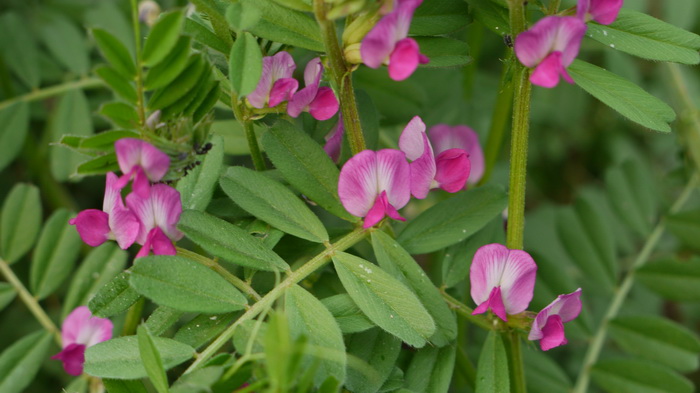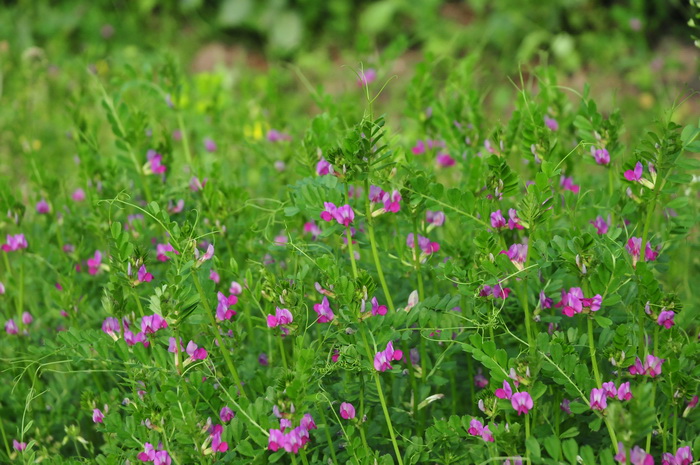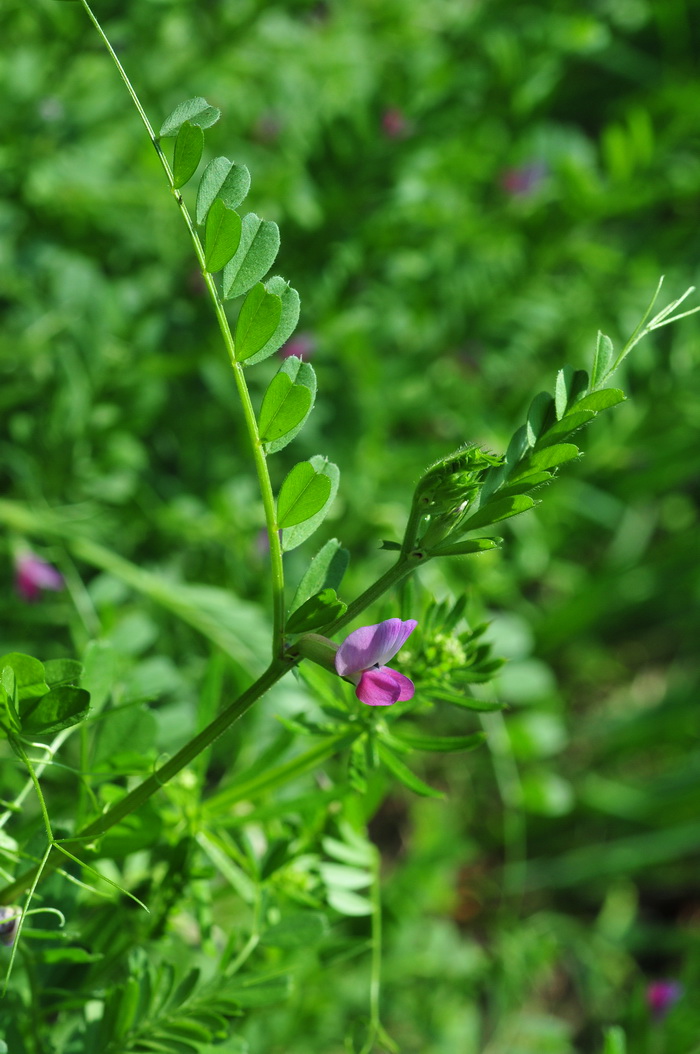大巢菜Vicia sativa
中文名(Chinese Name):大巢菜
学名(Scientific Name):Vicia sativa L.
英文名(English Common Name):garden vetch
别名(Chinese Common Name):救荒野豌豆
异名(Synonym):Vicia alba Moench Vicia bacla Moench Vicia communis Rouy Vicia notota Gilib. Vicia morisiana Boreau Vicia melanosperma Rchb. Vicia leucosperma Moench Vicia intermedia Viv. Vicia glabra Schleich. Vicia erythosperma Rchb. Vicia cosentini Guss. Vicia terana Losa Vicia pimpinelloides Mauri Vicia sativa subsp. terana (Losa)Benedi & Molero Vicia angustifolia var. bobartii KOCH Vicia sativa var. cordata Arcang.
科属(Family & Genus):蝶形花科,Fabaceae,野豌豆属
形态特征(Description):一年生或二年生草本,高15-90 (-105) 厘米。茎斜升或攀援,单一或多分枝,具棱,被微柔毛。偶数羽状复叶长2-10厘米,叶轴顶端卷须有2-3分支;托叶戟形,通常2-4裂齿,长0.3-0.4厘米,宽0.15-0.35厘米;小叶2-7对,长椭圆形或近心形,长0.9-2.5厘米,宽0.3-1厘米,先端圆或平截有凹,具短尖头,基部楔形,侧脉不甚明显,两面被贴伏黄柔毛。花1-2 (-4) 腋生,近无梗;萼钟形,外面被柔毛,萼齿披针形或锥形;花冠紫红色或红色,旗瓣长倒卵圆形,先端圆,微凹,中部缢缩,翼瓣短于旗瓣,长于龙骨瓣;子房线形,微被柔毛,胚珠4-8,子房具柄短,花柱上部被淡黄白色髯毛。荚果线长圆形,长约4-6厘米,宽0.5-0.8厘米,表皮土黄色种间缢缩,有毛,成熟时背腹开裂,果瓣扭曲。种子4-8,圆球形,棕色或黑褐色,种脐长相当于种子圆周1/5。花期4-7月,果期7-9月。
分布(Distribution):全国各地均产,生于海拔50-3000米荒山、田边草丛及林中。原产欧洲南部、亚洲西部,现已广为栽培。
用途(Use):为绿肥及优良牧草。全草药用。花果期及种子有毒,国外曾有用其提取物作抗肿瘤的报道。
引自植物志英文版:FOC Vol. 10 Page 561, 571
Vicia sativa Linnaeus, Sp. Pl. 2: 736. 1753.
救荒野豌豆 jiu huang ye wan dou | Fabaceae | Vicia
Herbs annual, 15-100 cm tall. Stem unbranched to much branched, decumbent or climbing, puberulent or pilose. Leaves paripinnate, 2-10 cm; stipules hastate, semisagittate, or lanceolate, ca. 1.5 mm, 2-5-toothed, puberulent; leaflets 2-7-paired, linear to oblong-cuneate to obcordate, 9-25 × 2-10 mm, hairy, apex acute, obtuse, truncate, or emarginate, mucronate; lateral veins not obvious; tendril 2- or 3-branched. Flowers 1 or 2(-4) in axillary fascicles. Calyx campanulate, hairy; teeth shorter than to longer than tube. Corolla blue-purple or purple to red, (8-)10-30 mm; standard long obovate or obovate, constricted at middle, subequaling or longer than wings; wings longer than keel. Ovary shortly stalked, linear or fusiform, puberulent or hairy; ovules 5-8. Legume black, brownish black, brown, or yellow-brown, linear or linear-oblong, slightly curved, contracted or not contracted between seeds, 25-70 × (2.5-)3-11 mm, pubescent to glabrous, apex beaked. Seeds 4-8, spheroid. Fl. Jan-Aug, fr. Feb-Sep. 2n = 10, 12, 14.
Wild or cultivated and possibly naturalized, forests, hedges, hill slopes, valleys, grasslands, dry pastures, damp grassy places, river and creek banks, river beds, farms, orchards, fields, cultivated land, margins of cultivation, wastelands, roadsides; sea level to 3700 m. Anhui, Chongqing, Fujian, Gansu, Guangdong, Guizhou, Hebei, Heilongjiang, Hubei, Hunan, Jiangsu, Nei Mongol, Sichuan, Taiwan, Xinjiang, Xizang, Yunnan, Zhejiang [Afghanistan, Bhutan, India, Japan, Kazakhstan, Korea, Kyrgyzstan, Mongolia, Nepal, Pakistan, Russia, Tajikistan, Turkmenistan, Uzbekistan; Africa, SW Asia, N Atlantic islands, Europe; widely introduced and naturalized elsewhere].


 (责任编辑:徐晔春)
(责任编辑:徐晔春)
学名(Scientific Name):Vicia sativa L.
英文名(English Common Name):garden vetch
别名(Chinese Common Name):救荒野豌豆
异名(Synonym):Vicia alba Moench Vicia bacla Moench Vicia communis Rouy Vicia notota Gilib. Vicia morisiana Boreau Vicia melanosperma Rchb. Vicia leucosperma Moench Vicia intermedia Viv. Vicia glabra Schleich. Vicia erythosperma Rchb. Vicia cosentini Guss. Vicia terana Losa Vicia pimpinelloides Mauri Vicia sativa subsp. terana (Losa)Benedi & Molero Vicia angustifolia var. bobartii KOCH Vicia sativa var. cordata Arcang.
科属(Family & Genus):蝶形花科,Fabaceae,野豌豆属
形态特征(Description):一年生或二年生草本,高15-90 (-105) 厘米。茎斜升或攀援,单一或多分枝,具棱,被微柔毛。偶数羽状复叶长2-10厘米,叶轴顶端卷须有2-3分支;托叶戟形,通常2-4裂齿,长0.3-0.4厘米,宽0.15-0.35厘米;小叶2-7对,长椭圆形或近心形,长0.9-2.5厘米,宽0.3-1厘米,先端圆或平截有凹,具短尖头,基部楔形,侧脉不甚明显,两面被贴伏黄柔毛。花1-2 (-4) 腋生,近无梗;萼钟形,外面被柔毛,萼齿披针形或锥形;花冠紫红色或红色,旗瓣长倒卵圆形,先端圆,微凹,中部缢缩,翼瓣短于旗瓣,长于龙骨瓣;子房线形,微被柔毛,胚珠4-8,子房具柄短,花柱上部被淡黄白色髯毛。荚果线长圆形,长约4-6厘米,宽0.5-0.8厘米,表皮土黄色种间缢缩,有毛,成熟时背腹开裂,果瓣扭曲。种子4-8,圆球形,棕色或黑褐色,种脐长相当于种子圆周1/5。花期4-7月,果期7-9月。
分布(Distribution):全国各地均产,生于海拔50-3000米荒山、田边草丛及林中。原产欧洲南部、亚洲西部,现已广为栽培。
用途(Use):为绿肥及优良牧草。全草药用。花果期及种子有毒,国外曾有用其提取物作抗肿瘤的报道。
引自植物志英文版:FOC Vol. 10 Page 561, 571
Vicia sativa Linnaeus, Sp. Pl. 2: 736. 1753.
救荒野豌豆 jiu huang ye wan dou | Fabaceae | Vicia
Herbs annual, 15-100 cm tall. Stem unbranched to much branched, decumbent or climbing, puberulent or pilose. Leaves paripinnate, 2-10 cm; stipules hastate, semisagittate, or lanceolate, ca. 1.5 mm, 2-5-toothed, puberulent; leaflets 2-7-paired, linear to oblong-cuneate to obcordate, 9-25 × 2-10 mm, hairy, apex acute, obtuse, truncate, or emarginate, mucronate; lateral veins not obvious; tendril 2- or 3-branched. Flowers 1 or 2(-4) in axillary fascicles. Calyx campanulate, hairy; teeth shorter than to longer than tube. Corolla blue-purple or purple to red, (8-)10-30 mm; standard long obovate or obovate, constricted at middle, subequaling or longer than wings; wings longer than keel. Ovary shortly stalked, linear or fusiform, puberulent or hairy; ovules 5-8. Legume black, brownish black, brown, or yellow-brown, linear or linear-oblong, slightly curved, contracted or not contracted between seeds, 25-70 × (2.5-)3-11 mm, pubescent to glabrous, apex beaked. Seeds 4-8, spheroid. Fl. Jan-Aug, fr. Feb-Sep. 2n = 10, 12, 14.
Wild or cultivated and possibly naturalized, forests, hedges, hill slopes, valleys, grasslands, dry pastures, damp grassy places, river and creek banks, river beds, farms, orchards, fields, cultivated land, margins of cultivation, wastelands, roadsides; sea level to 3700 m. Anhui, Chongqing, Fujian, Gansu, Guangdong, Guizhou, Hebei, Heilongjiang, Hubei, Hunan, Jiangsu, Nei Mongol, Sichuan, Taiwan, Xinjiang, Xizang, Yunnan, Zhejiang [Afghanistan, Bhutan, India, Japan, Kazakhstan, Korea, Kyrgyzstan, Mongolia, Nepal, Pakistan, Russia, Tajikistan, Turkmenistan, Uzbekistan; Africa, SW Asia, N Atlantic islands, Europe; widely introduced and naturalized elsewhere].
踩一下[0]

顶一下[1]